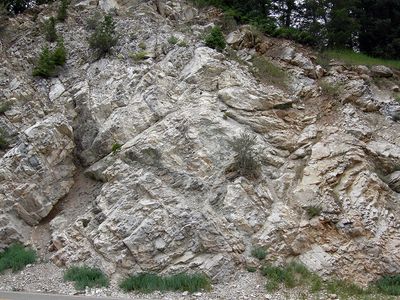Carboniferous

The Carboniferous was the fifth geological period of the Paleozoic era, extending from approximately 358.9 million to 298.9 million years ago. It consists of two sub-periods: the earlier Mississippian and the later Pennsylvanian. The Mississippian is divided into Upper, Middle, and Lower epochs, as is the Pennsylvania (Figure 1).[2] The name "Carboniferous" is derived from the latin word carbo for "charcoal" and ferrous for "bearing" or "carrying". The Carboniferous is the first period in which today's coal beds began to form.[3]
The Carboniferous was the period when faunal life became established on land. Floral life became established on land during the previous period, the Devonian period, and began to flourish during the Carboniferous (Figure 2). There was massive diversification of species for both plants and animals. The Carboniferous was a period of time that marked a decrease or extinction of many early Paleozoic organisms (e.g. stromatoporoid, tabulate corals, and trilobites) due to changing global conditions and newer, more competitive organisms (e.g. reptiles and amphibians (Figure 3)) beating them out for resources.[3] A key evolutionary development of the time was the amniote egg, an egg with a hard shell that contained all the needed materials within it for the development of the baby held within it (like a modern-day bird's egg), making the transition to land much easier for animals. The beginning of the Carboniferous, during the Mississippian subperiod, was tropical-like, humid, and had high oxygen levels. These conditions allowed insects to grow to an incredible size (Figures 4 and 5).[4]

- Figure 3. The early amphibian-like tetrapod, Pederpes.[6]
- Figure 4. Pulmonoscorpius reached a length of up to 70 cm.[7]
- Figure 5. Meganeura had wingspans of up to 75 cm.[8]
The Carboniferous saw the assembly of one of Earth's largest supercontinents, Pangea. All of the Earth's land masses combined into a singular continent causing major changes in ocean circulation. Combined with the development of terrestrial plants and the accompanying processes of photosynthesis and cellular respiration, the Carboniferous experienced increased continental weathering and erosion rates, strong fluctuations in atmospheric carbon dioxide, significant global cooling and warming events, and sea level changes. The increased availability of organic material accompanied by the ability to quickly bury the material (from the increased erosion rates) allowed for the widespread formation of the first coal beds. The end of the Carboniferous, during the Pennsylvanian subperiod, is marked by the Gondwana superglaciation.[3]

For Further Reading
References
- ↑ International Commission on Stratigraphy."International Chronostratigraphic Chart v2012" Accessed Nov.16, 2018 [Online]. Available: https://www.britannica.com/science/Mississippian-Subperiod/images-videos/media/385703/133170
- ↑ 2.0 2.1 International Commission on Stratigraphy."International Chronostratigraphic Chart v2018" Accessed Nov.8, 2018 [Online]. Available: http://www.stratigraphy.org/index.php/ics-chart-timescale
- ↑ 3.0 3.1 3.2 Gradstein, F. M. "The Geologic Time Scale 2012". Volume 2. 1st ed. Amsterdam ; Boston: Elsevier, 2012.
- ↑ University of California, Museum of Paleontology."The Carboniferous Period" Accessed Nov.16, 2018 [Online]. Available: http://www.ucmp.berkeley.edu/carboniferous/carboniferous.php
- ↑ WikiMedia Commons."File:Meyers b15 s0272b.jpg" Accessed Nov.16, 2018 [Online]. Available: https://en.wikipedia.org/wiki/File:Meyers_b15_s0272b.jpg
- ↑ WikiMedia Commons."File:Pederpes22small.jpg" Accessed Nov.16, 2018 [Online]. Available: https://en.wikipedia.org/wiki/File:Pederpes22small.jpg
- ↑ WikiMedia Commons."File:Pulmonoscopius BW.jpg" Accessed Nov.16, 2018 [Online]. Available: https://en.wikipedia.org/wiki/File:Pulmonoscopius_BW.jpg
- ↑ WikiMedia Commons. "File:Meganeura.jpg" Accessed Nov.16, 2018 [Online]. Available: https://en.wikipedia.org/wiki/File:Meganeura.jpg
- ↑ WikiMedia Commons."File:MississippianMarbleUT.jpg" Accessed Nov.16, 2018 [Online]. Available: https://en.wikipedia.org/wiki/File:MississippianMarbleUT.JPG


![Figure 3. The early amphibian-like tetrapod, Pederpes.[6]](/wiki/images/thumb/f/fb/Pederpes22small.jpg/462px-Pederpes22small.jpg)
![Figure 4. Pulmonoscorpius reached a length of up to 70 cm.[7]](/wiki/images/thumb/0/07/Pulmonoscopius_BW.jpg/203px-Pulmonoscopius_BW.jpg)
![Figure 5. Meganeura had wingspans of up to 75 cm.[8]](/wiki/images/thumb/6/68/Meganeura.jpg/243px-Meganeura.jpg)